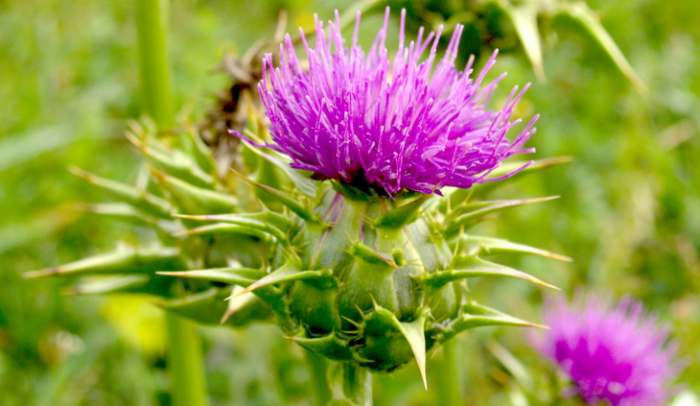Silimarine – Silybum marianum or Carduus marianus (milk thistle)
Silimarine protects the liver from various toxic substances, decrease the level of cholesterol and have antioxidance activity
There is already some bibliography on this plant (598-605). It belongs to the Asteraceae family, it originated and is common in the countries of the Mediterranean basin and the Middle East, particularly in uncultivated, sunny spots. The pharmaceutical preparation is by means of a dry extraction, taken from the flowertops and the seeds, nebulized and titrated in a solution of Silimarine min. 1.0%.
The principle components are the flavonolignans, which are isolated in the form of a mixture of condensation products called Silimarine, which represents from 1.5 to 3% of the drug. Furthermore, there are also present notable quantities of lipids (mainly poly-unsaturated) as well as moderate quantities of Beta-sitosterol, Silibinine, Isolibinine and Silichristina.

Silimarine mainly performs a protective action on the liver.
In fact it is able to protect the hepatocyte from various toxic substances, such as for example Phallodine, carbon Tetrachloride, Galactosamine, Thioacetamide etc.
In the case of Phallodine, the protective effect of Silimarine is to be attributed to the competitive block of the Phallodine link to the receptors situated on the surface of the hepatocyte membrane. In this way the Phallodine is prevented from penetrating to the inside of the hepatocyte; Silybum marianum is also able to stimulate the formation of new hepatocytes more quickly than the phallodine is able to destroy them.
This indicates that it may be able to stimulate proteic synthesis in the hepatocytes.
Silimarine also has a stabilizing effect on the hepatocyte membrane and on the internal membranes of the cytoplasmatic organelles, which can probably be attributed to its action of inhibiting lipidic peroxidation, as a consequence of its ability to capture the free radicals.
Silimarine’s ability to stabilize the membrane can therefore be traced to its ability to inhibit the turn-over of the phospholipidic components of the hepatocyte membranes, and its ability to reduce to a considerable extent the speed of the exchange process of the bases on the membrane level. It would therefore seem that inhibiting this system produces a stabilization of the membrane metabolism. This leads, in
the final analysis, to an inhibition in the formation of lipoperoxides.
Silimarine induces a considerable decrease in the transaminases, in GT gamma, in lacticdehydrogenases (LDH) and in bilirubin, in patients with hepatopathy caused by viral hepatitis (types A, B and C) and ethylic hepatitis (through the reduction of aldehyde thanks to the stimulation of dehydrogenase-alcohol).
It is also able to protect the liver when it is damaged, induced both iatrogenically and by toxic substances such as insecticides, antiparasites or by agents inadvertently introduced into the food chain such as Falloid Amanita.
Its antioxidative action can also be attributed in part to its proven ability to increase the hepatic levels of Glutathione, by means of a mechanism which is so far unknown.
Its action of decreasing total cholesterol and the triglicerides must be highlighted, attributable, in part, to a better activation of the hepatic metabolism, with consequent optimal use of the lipidic pool by the hepatocyte.
The recommended daily dosage is between 600 mg and 1,200 mg, taken in two doses, preferably between meals.
It must be highlighted that it reduces insulin resistance in chronic hepatitis, with a consequent decrease in glycemia and glycosuria. It also accelerates protein biosynthesis and accelerates cellular regeneration. It inhibits the production of leukotrienes carrying out an anti-inflammatory action and, in part, an anti-allergic action too. Because of the presence of a moderate amount of Tyramine some authors advise administering it with a certain degree of caution in the case of hypertension.
Because of its Tyramine content, it could also interfere with anti-MAO medicines, which in any case it is no longer advisable to prescribe in pharmacological therapy.
Source: The book Thousand Plants against Cancer without Chemo-Therapy, author Giuseppe Nacci, M.D
